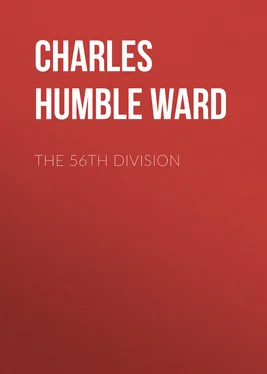Charles Humble Dudley Ward - The 56th Division
Здесь есть возможность читать онлайн «Charles Humble Dudley Ward - The 56th Division» — ознакомительный отрывок электронной книги совершенно бесплатно, а после прочтения отрывка купить полную версию. В некоторых случаях можно слушать аудио, скачать через торрент в формате fb2 и присутствует краткое содержание. Жанр: foreign_prose, История, foreign_edu, foreign_antique, на английском языке. Описание произведения, (предисловие) а так же отзывы посетителей доступны на портале библиотеки ЛибКат.
- Название:The 56th Division
- Автор:
- Жанр:
- Год:неизвестен
- ISBN:нет данных
- Рейтинг книги:5 / 5. Голосов: 1
-
Избранное:Добавить в избранное
- Отзывы:
-
Ваша оценка:
- 100
- 1
- 2
- 3
- 4
- 5
The 56th Division: краткое содержание, описание и аннотация
Предлагаем к чтению аннотацию, описание, краткое содержание или предисловие (зависит от того, что написал сам автор книги «The 56th Division»). Если вы не нашли необходимую информацию о книге — напишите в комментариях, мы постараемся отыскать её.
The 56th Division — читать онлайн ознакомительный отрывок
Ниже представлен текст книги, разбитый по страницам. Система сохранения места последней прочитанной страницы, позволяет с удобством читать онлайн бесплатно книгу «The 56th Division», без необходимости каждый раз заново искать на чём Вы остановились. Поставьте закладку, и сможете в любой момент перейти на страницу, на которой закончили чтение.
Интервал:
Закладка:
The right brigade of the 16th Division was not relieved for some time. The guides to the relieving battalion lost themselves completely, and a big gap existed between Ginchy and Guillemont. During the 10th this gap was made good, but the whole of that day was occupied by repulsing enemy attacks and trying to establish a definite line.
On the 56th Division front there were repeated bombing attacks by the enemy, and the S.O.S. was sent up several times. We may say that the battalion reports of positions were only relatively accurate, and that nothing was clear to Gen. Hull until the weather improved and air reports could be made.
Relief of the 168th Brigade by the 167th, and of the 169th by a composite brigade of the 5th Division, took place, and it was then ascertained that the London Scottish had, as related above, lost direction in their attack and that no one was near the Ginchy—141·7 road. The enemy still held the Quadrilateral in force, and the most advanced troops of the 56th Division were some way from it, though they were strongly established in Bully Trench; and the enemy were still in square 20. But the 56th and Guards Divisions were now in touch and a firm line was held along the Guillemont—Leuze Wood road, and from the cross-roads to Ginchy, which was also firmly held.
The Quadrilateral was the danger-point, and it defied all attempts to take it by bombing, and successfully withstood the Corps heavy artillery.
Sir Douglas Haig sums up the situation at this point as follows:
“… The French had made great progress on our right, bringing their line forward to Louage Wood (just south of Combles), Le Foret, Cléry-sur-Somme, all three inclusive. The weak salient in the Allied line had therefore disappeared, and we had gained the front required for further operations.
Still more importance, however, lay in the proof afforded in the results described of the ability of our new armies not only to rush the enemy’s strong defences—as had been accomplished on the 1st and 14th July—but also to wear down and break the power of resistance by a steady relentless pressure, as had been done during the weeks of this fierce and protracted struggle. As has already been recounted, the preparations made for our assault on the 1st July had been long and elaborate; but though the enemy knew that an attack was coming, it would seem that he considered the troops already on the spot, secure in their apparent impregnable defences, would suffice to deal with it. The success of that assault, combined with the vigour and determination with which our troops pressed their advantage, and followed by the successful attack on the night of 14th July, all served to awaken him to a fuller realisation of his danger. The great depth of his system of fortifications, to which reference has been made, gave him time to reorganise his defeated troops, and to hurry up numerous fresh divisions and more guns. Yet in spite of this he was still pushed back, steadily and continuously. Trench after trench, and strong point after strong point, were wrested from him. The great majority of his repeated counter-attacks failed completely, with heavy loss; while the few that achieved temporary success purchased it dearly, and were soon thrown back from the ground they had for the moment regained.
The enemy had, it is true, delayed our advance considerably, but the effort had cost him dear; and the comparative collapse of his resistance during the last days of the struggle justified the belief that in the long-run decisive victory would lie with our troops, who had displayed such fine fighting qualities and such indomitable endurance and resolution.
Practically the whole of the forward crest of the main ridge, on a front of some 9,000 yards from Delville Wood to the road above Mouquet Farm, was now in our hands, and with it the advantage of observation over the slopes beyond. East of Delville Wood, for a further 3,000 yards to Leuze Wood, we were firmly established on the main ridge; while farther east, across the Combles valley, the French were advancing victoriously on our right. But though the centre of our line was well placed, on our flanks there was still difficult ground to be won.
From Ginchy the crest of the high ground runs northwards for 2,000 yards, and then eastward, in a long spur, for nearly 4,000 yards. Near the eastern extremity of the spur stands the village of Morval, commanding a wide field of view and fire in every direction. At Leuze Wood my right was still 2,000 yards from its objective at this village, and between lay a broad and deep branch of the main Combles valley, completely commanded by the Morval spur, and flanked, not only from its head north-east of Ginchy, but also from the high ground east of the Combles valley, which looks directly into it.
Up this high ground beyond the Combles valley the French were working their way towards the objective at Sailly-Saillisel, situated due east of Morval, and standing at the same level. Between these two villages the ground falls away to the head of the Combles valley, which runs thence in a south-westerly direction. In the bottom of this valley lies the small town of Combles, then well fortified and strongly held, though dominated by my right at Leuze Wood, and by the French left on the opposite heights. It had been agreed by the French and myself that an assault on Combles would not be necessary, as the place could be rendered untenable by pressing forward along the ridges above it on either side.
The capture of Morval from the south side presented a very difficult problem, while the capture of Sailly-Saillisel, at that time some 3,000 yards to the north of the French left, was in some respects even more difficult. The line of the French advance was narrowed almost to a defile by the extensive and strongly fortified wood of St. Pierre Vaast on the one side, and on the other by the Combles valley, which, with the branches running out of it and the slopes on either side, is completely commanded, as has been pointed out, by the heights bounding the valley on the east and west....
The general plan of the combined Allied attack which was opened on the 15th September was to pivot on the high ground south of the Ancre and north of the Albert-Bapaume road, while the Fourth Army devoted its whole effort to the rearmost of the enemy’s original systems of defence between Morval and Le Sars.
Should our success in this direction warrant it, I made arrangements to enable me to extend the left of the attack to embrace the villages of Martinpuich and Courcelette. As soon as our advance on this front had reached the Morval line, the time would have arrived to bring forward my left across the Thiepval Ridge. Meanwhile our Allies arranged to continue the line of advance in close co-operation with me from the Somme to the slopes above Combles; but directed their main effort northwards against the villages of Rancourt and Frigicourt, so as to complete the isolation of Combles and open the way for their attack on Sailly-Saillisel.”
That much was hoped from the big attack, to take place on the 15th, there can be no doubt. Brigades resting in the rear of the divisional area could see quantities of cavalry still farther back. It suggested big results.
The limits of the Fourth Army attack were Combles Ravine and Martinpuich, and it was to capture Morval, Les Bœufs, Gueudecourt, and Flers. The Cavalry Corps was to have its head on Carnoy at 10 a.m., and as soon as the four villages had been captured it would advance and seize the high ground round Rocquigny, Villers-au-Flos, Riencourt-les-Bapaume, and Bapaume.
And it was the first battle in which Tanks were employed! [The battle of Flers-Courcelette.]
Even in the midst of the struggle round about the Quadrilateral a steady bombardment had been going on, in preparation of a further attack, since the 12th September. Day firing commenced at 6 a.m. and went on until 6.30 p.m., when night firing started. During the night bombardment lethal shells were used.
Читать дальшеИнтервал:
Закладка:
Похожие книги на «The 56th Division»
Представляем Вашему вниманию похожие книги на «The 56th Division» списком для выбора. Мы отобрали схожую по названию и смыслу литературу в надежде предоставить читателям больше вариантов отыскать новые, интересные, ещё непрочитанные произведения.
Обсуждение, отзывы о книге «The 56th Division» и просто собственные мнения читателей. Оставьте ваши комментарии, напишите, что Вы думаете о произведении, его смысле или главных героях. Укажите что конкретно понравилось, а что нет, и почему Вы так считаете.




![Александр Ирвин - Tom Clancy’s The Division 2. Фальшивый рассвет [litres]](/books/417744/aleksandr-irvin-tom-clancy-s-the-division-2-falsh-thumb.webp)







